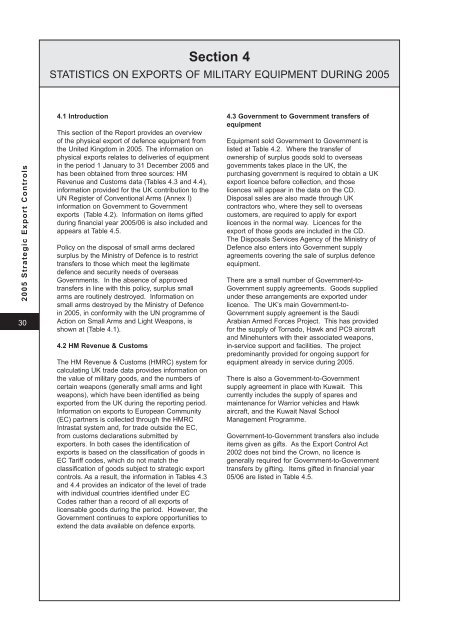Annex A - Official Documents
Annex A - Official Documents
Annex A - Official Documents
You also want an ePaper? Increase the reach of your titles
YUMPU automatically turns print PDFs into web optimized ePapers that Google loves.
2005 Strategic Export Controls<br />
30<br />
Section 4<br />
STATISTICS ON EXPORTS OF MILITARY EQUIPMENT DURING 2005<br />
4.1 Introduction<br />
This section of the Report provides an overview<br />
of the physical export of defence equipment from<br />
the United Kingdom in 2005. The information on<br />
physical exports relates to deliveries of equipment<br />
in the period 1 January to 31 December 2005 and<br />
has been obtained from three sources: HM<br />
Revenue and Customs data (Tables 4.3 and 4.4),<br />
information provided for the UK contribution to the<br />
UN Register of Conventional Arms (<strong>Annex</strong> I)<br />
information on Government to Government<br />
exports (Table 4.2). Information on items gifted<br />
during financial year 2005/06 is also included and<br />
appears at Table 4.5.<br />
Policy on the disposal of small arms declared<br />
surplus by the Ministry of Defence is to restrict<br />
transfers to those which meet the legitimate<br />
defence and security needs of overseas<br />
Governments. In the absence of approved<br />
transfers in line with this policy, surplus small<br />
arms are routinely destroyed. Information on<br />
small arms destroyed by the Ministry of Defence<br />
in 2005, in conformity with the UN programme of<br />
Action on Small Arms and Light Weapons, is<br />
shown at (Table 4.1).<br />
4.2 HM Revenue & Customs<br />
The HM Revenue & Customs (HMRC) system for<br />
calculating UK trade data provides information on<br />
the value of military goods, and the numbers of<br />
certain weapons (generally small arms and light<br />
weapons), which have been identified as being<br />
exported from the UK during the reporting period.<br />
Information on exports to European Community<br />
(EC) partners is collected through the HMRC<br />
Intrastat system and, for trade outside the EC,<br />
from customs declarations submitted by<br />
exporters. In both cases the identification of<br />
exports is based on the classification of goods in<br />
EC Tariff codes, which do not match the<br />
classification of goods subject to strategic export<br />
controls. As a result, the information in Tables 4.3<br />
and 4.4 provides an indicator of the level of trade<br />
with individual countries identified under EC<br />
Codes rather than a record of all exports of<br />
licensable goods during the period. However, the<br />
Government continues to explore opportunities to<br />
extend the data available on defence exports.<br />
4.3 Government to Government transfers of<br />
equipment<br />
Equipment sold Government to Government is<br />
listed at Table 4.2. Where the transfer of<br />
ownership of surplus goods sold to overseas<br />
governments takes place in the UK, the<br />
purchasing government is required to obtain a UK<br />
export licence before collection, and those<br />
licences will appear in the data on the CD.<br />
Disposal sales are also made through UK<br />
contractors who, where they sell to overseas<br />
customers, are required to apply for export<br />
licences in the normal way. Licences for the<br />
export of those goods are included in the CD.<br />
The Disposals Services Agency of the Ministry of<br />
Defence also enters into Government supply<br />
agreements covering the sale of surplus defence<br />
equipment.<br />
There are a small number of Government-to-<br />
Government supply agreements. Goods supplied<br />
under these arrangements are exported under<br />
licence. The UK’s main Government-to-<br />
Government supply agreement is the Saudi<br />
Arabian Armed Forces Project. This has provided<br />
for the supply of Tornado, Hawk and PC9 aircraft<br />
and Minehunters with their associated weapons,<br />
in-service support and facilities. The project<br />
predominantly provided for ongoing support for<br />
equipment already in service during 2005.<br />
There is also a Government-to-Government<br />
supply agreement in place with Kuwait. This<br />
currently includes the supply of spares and<br />
maintenance for Warrior vehicles and Hawk<br />
aircraft, and the Kuwait Naval School<br />
Management Programme.<br />
Government-to-Government transfers also include<br />
items given as gifts. As the Export Control Act<br />
2002 does not bind the Crown, no licence is<br />
generally required for Government-to-Government<br />
transfers by gifting. Items gifted in financial year<br />
05/06 are listed in Table 4.5.

















